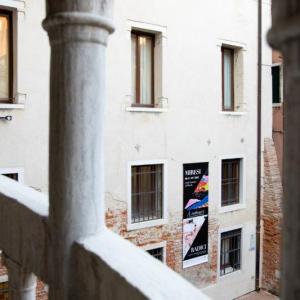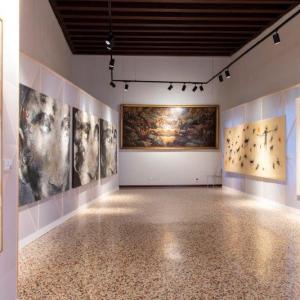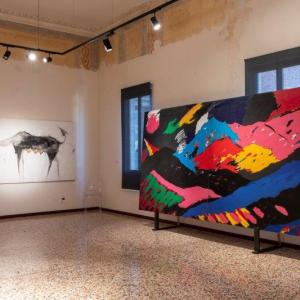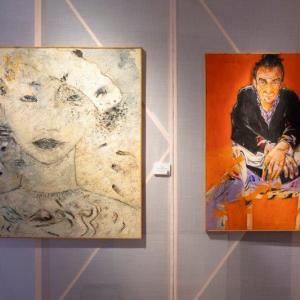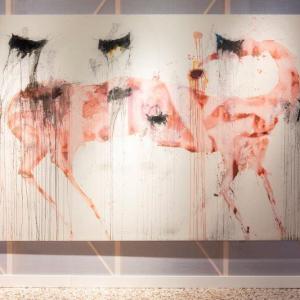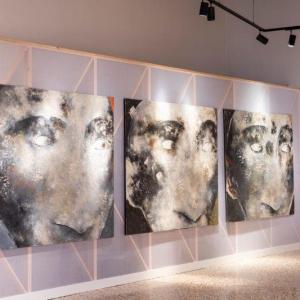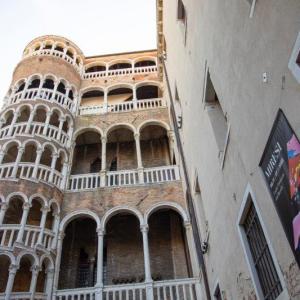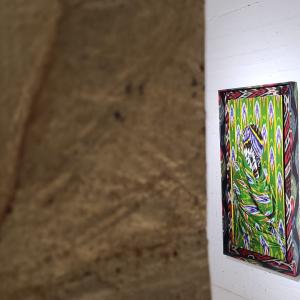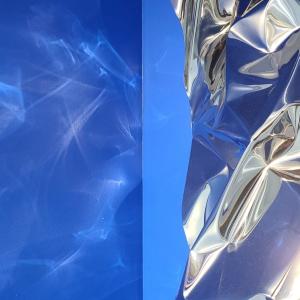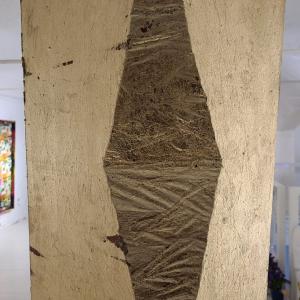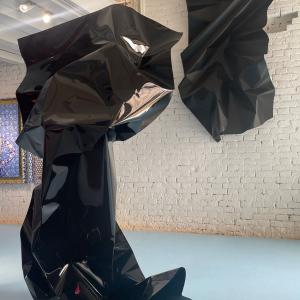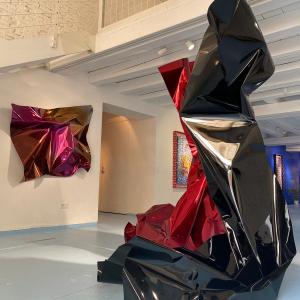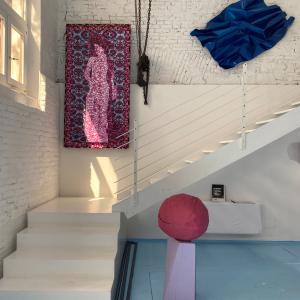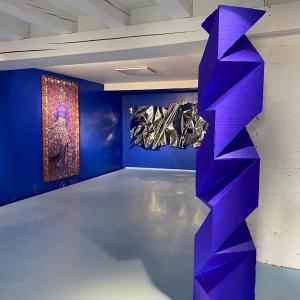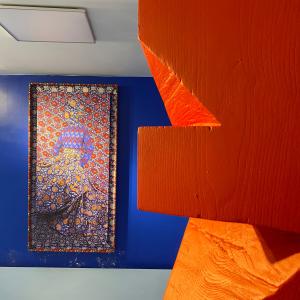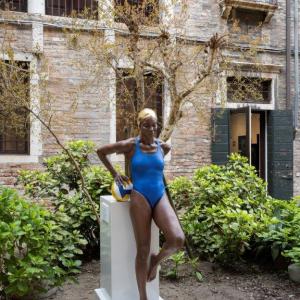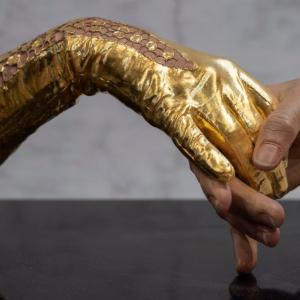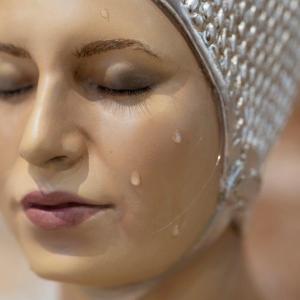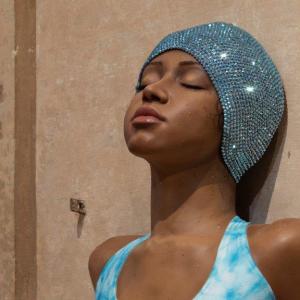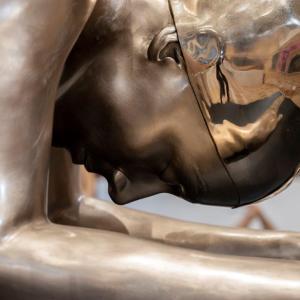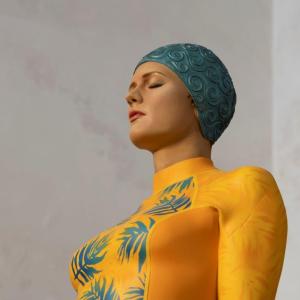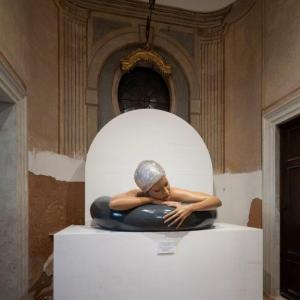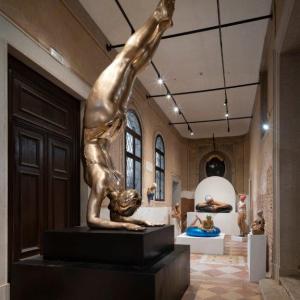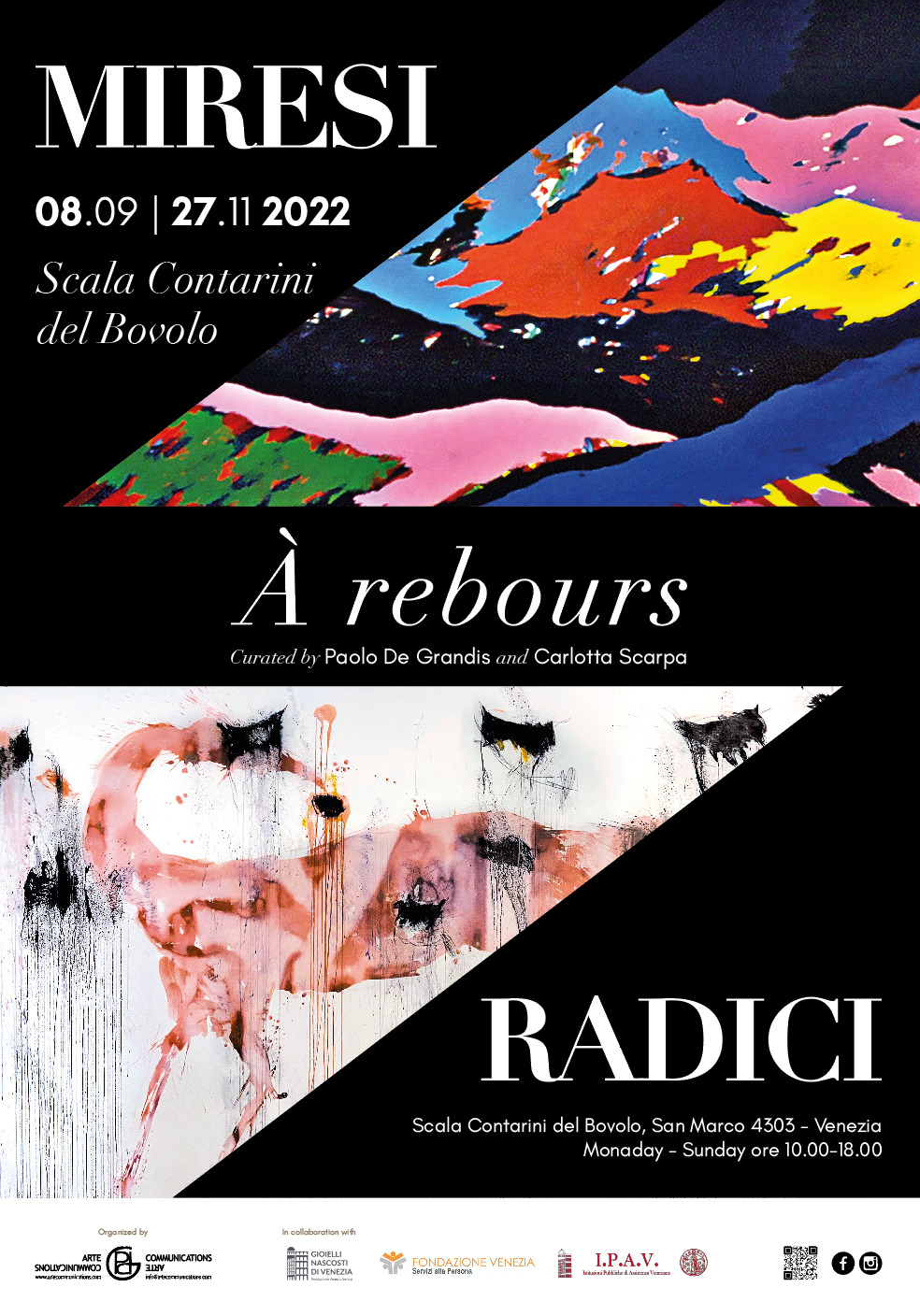
MIRESI I RADICI À rebours
Scala Contarini del Bovolo
8 September - 27 November
Opening hours: daily, 10 a.m. to 6 p.m.
After five years, Miresi and Maurizio Radici return to Venice with the exhibition À rebours, a four-hands project in the exhibition rooms of the monumental complex of the Scala Contarini del Bovolo.
Curated by Paolo De Grandis and Carlotta Scarpa, organized by PDG Arte Communications, the exhibition takes its cue from the translation of the title as “backwards” and “against the flow”. And it is precisely on this ambivalence that the exhibition path is built, confronting Miresi’s and Radici’s works which are poised between dark but strongly suggestive figurative choices, and going as far as abstract experiments where the colours explode in all their vigour.
Miresi’s and Radici’s works dialogue by assonance and contrast with the intention of creating a narrative that can offer a new key to their vast artistic production. If in the Tintoretto room the works overlap with different thematic and stylistic choices, in the second room Maurizio Radici drew direct inspiration from Miresi’s colours to create a cycle of site-specific works in perfect harmony with them.
Miresi retraces a hypothetical journey in retrospect, whether captured by a temporal peculiarity or by the presence of the artist's memory, which gives memories a state of immanence. The narrative and thematic choice is divided into two threads, the first follows the figurative beginnings between the 1980s and 1990s with the Auditorium cycle. In these works, the details of an eye or an ear emerge until a delicate child's profile is defined, where the pictorial surface from time to time experiences a tonal mobility causing the forms to oscillate between curvilinear sweeps and more severe graphic elements. Standing at the centre of the exhibition is the imposing Inquisition triptych, a historical work that the artist has revisited several times, but which always appears as a mirror of burning topicality. This painting has been executed in7 variants from 1993 to the present day.
The second thread acts as a counterpoint to the S/ Landscape series characterised by an abstract stylistic rendering where colours burst onto the canvas in both stylised and informally derived forms. In particular, the monumental painting S/Landscape xyz depicts a view of a mountain, but set in a fixed time where the colour seems to float on the canvas in an expressive tension deliberately dilated by the imposing dimensions of the painting as if the artist wanted to give it an unlimited spatial connotation.
Instead, the artistic philosophy of Maurizio Radici is nourished by figures, animals, signs, primordial shadows, matrices of images generated by still colour or by sudden flashes that the artist ignites through the vigorous use of brushstrokes. And it is precisely in this continuous narration that, in the act of painting, Radici rediscovers certain semantic codes in which myth, dream and present time are combined and together open up to an infinite series of questions. Radici’s canvases stimulate the eye through mythological figures where signs and symbols, sometimes animated by a very rapid graphism, become the caesuras within which he treats his invisible worlds.
He has a way of making art that goes against the flow: he investigates the human figure captured in energetic compositions that tend towards abstract and swirling expressions, instead he fixes the representation of animals in a formal stasis and interrogates myth and memory as a fact to be traversed. In Maurizio Radici’s pictorial narrative, we can grasp a marvellous blend of philosophical, religious and moral insights that give voice to our human anxieties.
Miresi lives and works between Garda and Berlin. His artistic activity took shape and methodological continuity in the early 1980s, at the time of the resurgence of aniconic painting culture. In particular around the group of new abstract painters followed by Giorgio Cortenova, who, through their works, traces a panorama of young abstraction, against the flow in those years of triumphant figurativeness. And Miresi immediately came to the fore as a protagonist of the new research that rejected post-modern theories. In this context, he also exhibited at the 11th Quadriennale in Rome (1986), curated by Giuseppe Gatt. From the second half of the 1990s, the artist began to work and live in Berlin. Since this period, his art has been directed towards iconic themes within which his language expands in a tight space-surface dialectic; an issue that began with his abstract experiences and today finds within it the revelation of the image of everyday forms that can be identified through photography in the continuous relationship of signs with painting. Since 2010, Miresi has been developing his passion for photography in a mix with painting, working increasingly on the attempt to identify a new contemporary icon in the use of different media. Miresi has exhibited in many Italian and European state galleries and museums. These include: Les Chances de l'Art, Bolzano (1994); Investitions Bank Berlin, Berlin (1998); WFP, Berlin (1998); Maria Skelling Gallery, Copenhagen (2010); ACIT, Palazzo Albrizzi, Venice (2014); OPEN 17, International Exhibition of Sculptures and installations, Island of San Servolo, Venice (2014); Deutsch-Russisches Museum, Berlin-Karlshorst (2015); Kunstdetektor Ateliertouren, Berlin (2016); OPEN 20, International Exhibition of Sculptures and installations, Venice (2017); XVI International Architecture Exhibition, Venice Arsenal (2018); Glances and Architectures, Galleria d’Arte Moderna and Musei Capitolini alla Centrale Montemartini, Rome (2020).
Maurizio Radici was born in Palazzolo sull'Oglio in 1958. He graduated in graphics and architecture and in the 1980s attended the Academy of Carrara and Fine Arts in Bergamo, having the opportunity to be mentored by well-known Italian masters, including Italo Ghilardi. From childhood, he experienced a climate that was particularly attentive to art and painting techniques, and certainly his father, who was a very successful colour chemist, passed on his knowledge of the subject to his son in its most specific and sophisticated aspects. Radici is an artist who has made painting his full-time job. From an early age, he devoted himself to painting and sculpture and gained experience in advertising graphics as an art director. He has held exhibitions in Italian and international museums and galleries: Todi, Venice, Milan, Stuttgart, New York, Bergamo, Rimini, Macerata, Ancona, Bologna, Brescia, Naples, Genoa, Cagliari, Venice, London, Amsterdam, Rome, Collinas, Gambettola (Cesena Forlì).
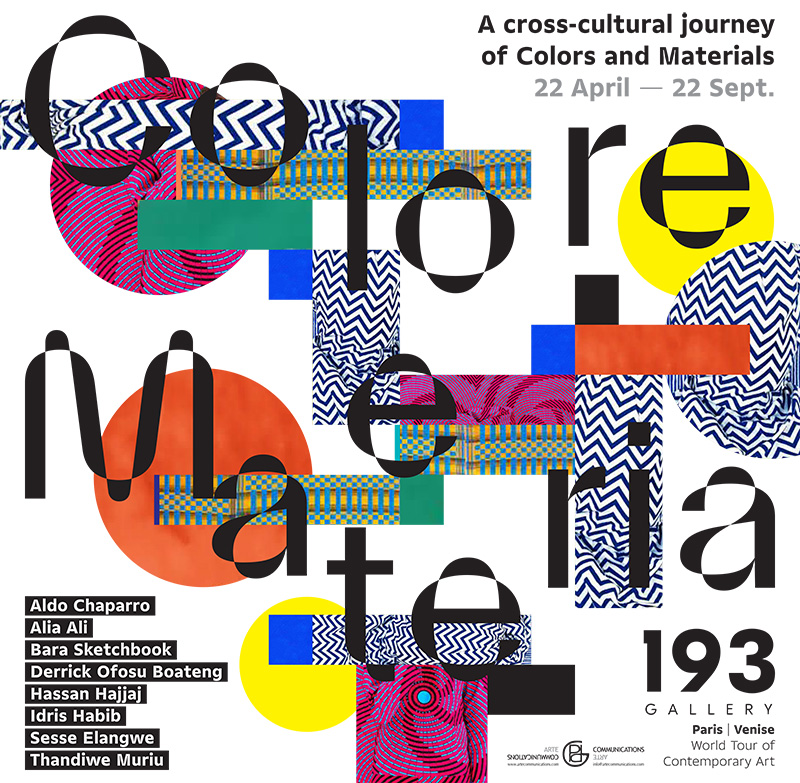
Colore e Materia
A cross-cultural journey with artworks by
Aldo Chaparro, Alia Li, Bara Sletchbook, Derrick Ofosu Boateng,
Hassan Hajjaj, Idris Habib, Sesse Elangwe, Thandiwe Muriu
Dorsoduro 556 (next to the Academy of Fine Arts in Venice)
20.04 – 22.10 2022
Opening hours: 10.30 -19.00
The 193 Gallery is glad to announce its debut in Venice with the exhibition Colore e Materia, to be held from 20th April to 22nd October in parallel to the Biennale Arte 2022 at Dorsoduro 556, a magnificent venue dates from the 17th century next to the Academy of Fine Arts and a few steps from the Peggy Guggenheim Foundation, the Fondazione Vedova and Punta della Dogana.
Colore e Materia (Colour and Material) is the umbrella concept gathering 3 exhibitions every two months presenting 8 international artists which best represents the 193 Gallery mission. In a time when fears and divisions overwhelm unity, our artists express identity and beauty through vivid textiles, colours, different materials, taking us to a cross-cultural journey that unites us all.
More than just a visual phenomenon, Colore e Materia brings emotional and cultural dimensions that enhance communication among people and represent strong symbolisms with which the artists can express themselves in a powerful way.
...OR WAS IT A DREAM ? ALIA ALI & ALDO CHAPARRO (April 22nd - June 22nd) curated by the 193 Gallery curator's team is the first exhibition. A duo show where we will present multi-media artist Alia Ali (Yemen/Bosnia/US) and sculptor Aldo Chaparro (México).
Alia Ali works on subjects like migration, social exclusion and histories of colonialism, and her photographs are mounted on aluminium Dibond and framed upholstered in unique fabrics from all over the world. She challenges culturally sanctioned oppression and confronts the dualistic barriers of conflicted notions of gender, politics, media and citizenship.
Aldo Chaparro works with a long-term methodology: to establish tension with the materials to ultimately transform them. He will show spontaneous sculptures created with different materials like iron and wood.
Opening dates:
For the first exhibition …OR WAS IT A DREAM? ALIA ALI & ALDO CHAPARRO there will be previews for collectors during the 19th 20th and 21st of April and the official openings (vernissage) will take place during two consecutive weekends, the 22nd & 23rd and the 29th & 30th of April starting at 5pm.
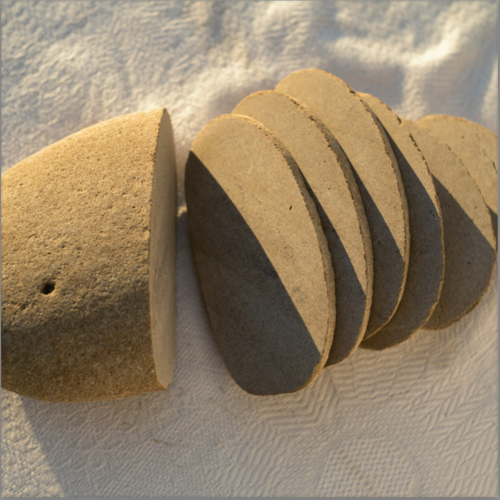
ZHANNA KADYROVA
PALIANYTSIA
Fundraising project - Emergency in Ukraine
Castello 2145 | Riva San Biasio 30122 Venezia
21 April – 30 June 2022
Opening: Wednesday 20 April 2022 | From 10am to 8pm
During The 59th International Art Exhibition La Biennale di Venezia, Galleria Continua is proud to present “PALIANYTSIA” by Ukrainian artist, Zhanna Kadyrova. More than an exhibition, this project is a demonstration that aims to allow the artist to tell not only her story but the story of many Ukrainians in this historic and tragic moment. This project presents works in stone as well as works on paper and a documentary film by Ivan Sautkin, realized by professional directors from Kiev, Olena Zashko and Ganna Yeresko.
In this frightening instance, in which over 6.5 million Ukrainians are displaced internally and externally and many have abandoned their professions to fight for the freedom of their nation, Zhanna Kadyrova has conceived and realized this project from a location in Western Ukraine, a village called Berezovo that’s based 30 km from the Hungarian border, scouted out by herself and her co-author Denis Ruban. The location is isolated and they have managed to convert an outhouse into an exhibition and studio space, installing electricity and heating. Protected by the Carpathian Mountains, it’s a place through which many rivers run, smoothing the large stones that lie in and around them: these reminded the artist of a typical loaf of bread found throughout Ukraine.
“Palianytsia” means bread, typically a large round wheat bread, baked in an oven. It’s a word that, since the Russian invasion of Ukraine, has taken on a new meaning; since Russian occupiers cannot pronounce the word properly, it’s become a type of shibboleth, distinguishing friends from enemies. These works therefore take on an extra meaning, representing not only a fundamental life source that crosses all boundaries of society but an identifier. They are a symbol of sustenance and resistance made from a common, found material that in its new form represents a profound and life changing experience being lived by a whole nation.
Zhanna Kadyrova has always worked with recycled and commonly used materials associated with the construction and architectural industry, such as tiles, ceramics, bricks and concrete. Her artistic research is linked to the historical context, to Soviet propaganda materials, to post- Soviet modernity, to the idea of community, to the concept of public space both in relation to the private and the collective and to the
ARTE COMMUNICATIONS
relationship between works of art and visitor. Rather than offering the viewer images or representations of elements of civilization, her works highlight the visual systems used to convey messages and influence society.
The project will also involve a performance; the emission of air- raid sirens outside the space on Riva San Biasio, at the same time each day for the three opening days of La Biennale di Venezia: “The Venice Biennale is known for being the most important and prestigious international contemporary art exhibition. Our exhibition is intended for the representatives of the world cultural community that meets in these pre-opening days. By filling the Giardini and the Arsenale with the scream of the anti-alarm sirens, we want to make people hear what ordinary people in Ukraine have been hearing every day for more than a month; people who live under the bombings, people who are at home and simply want to live in their country.”, declares the artist. Through “PALIANYTSIA” Zhanna Kadyrova wants to spread her message: that every artistic gesture makes us visible and makes the voices of the Ukrainian people heard!
“PALIANYTSIA” is a project by Zhanna Kadyrova with the collaboration of Denis Ruban and Ivan Sautkin, curated by Veronica Siciliani Fendi, Giovanni Giacomo Paolin is the project manager with special thanks to Olga Strada, Alona Tyshchenko and Ivan Yastrebov and particular recognition goes to Yuriy Solodukha.
Zhanna Kadyrova was born in 1981 in Brovary, in the Kyiv region, Ukraine, where she currently lives and works. Member of “R.E.P.” group (Revolution Experimental Space). After graduating from the Taras Shevchenko State Art School in 1999, she received the Kazimir Malevich Artist Award and the Grand Prix of the Kyiv Sculpture Project (both 2012). She was awarded the Special Prize (2011), Main Prize (2013) and Special Prize – Future Generation International (2014), all by PinchukArtCentre.
Her most recent projects are all site specific, including an outdoor installation in the Semmering Mountains (Austria), a spread intervention and perma- nent sculpture in the village of Tolfa (Italy) a and a sculptural project for the Shanghai Jing’an International Sculpture Project (JISP) in Shanghai (China).
She participated in numerous international exhibitions, including the 58th, 56th and 55th Venice Biennale, the 5th Moscow Biennale, the 2017 Kyiv Biennale and “CrackUpCrackDown”, the 33rd Biennial of Graphic Arts in Ljubljana, Slovenia. Her work has been exhibited nationally and internationally, including exhibi- tions at Centre Pompidou, Palais Tokyo; La Kunsthalle Mulhouse (all France), Kunstraum Innsbruck (Austria) Ludwig Museum, Budapest (Hungary), Museum of Modern Art; Uyazdovski Castle, Warsaw (both Poland), Spinnerei Leipzig; Badischer Kunstverein, Karlsruhe; DAAD, Zimmerstrabe, Berlin (all Germany), the National Union of Cuban Architects and Construction Engineers, Havana (Cuba), Sara Hilden Museum, Tampere (Finnland), Lviv Municipal Art Center, Lviv, National Art Museum of Ukraine and PinchukArtCentre, Kyiv (all Ukraine).
In March 2022, Kadyrova should have started her residency in Peyrassol (France) to work on ‘Island’, a permanent site specific project and then go back to Kyiv to prepare her first major retrospective that should be held at the PinchukArtCentre in 2023. The recent war unleashed by Russia against Ukraine has changed all the plans. Zhanna had to leave her home and studio in Kyiv and is currently located in the Transcarpathian region (western Ukraine).
Kadyrova’s practice, tackling since its very beginning disciplines as differ- ent as sculpture, photo, video, performance, deeply focuses on the exhibi- tion site and space. In her work, the issue of context unravels to reveal the rhythm of History on the move - that of a world whose multiple layers dis- appear behind their immediacy. Often diverting the aesthetic canons of the socialist ideal still present in the heritage of contemporary Ukraine, Kadyrova’s per- spective is partially informed by the plastic and symbolic values of urban building materials. Thus, ceramics, glass, stone and concrete enter the spotlight of her work.
Zhanna Kadyrova is represented by GALLERIA CONTINUA San Gimignano, Beijing, Les Moulins, Habana, Roma, Sao Paulo, Paris, and ZAHORIAN & VAN ESPEN Bratislava / Prague.
For press or social media requests, please contact Phoebe Owston, communication and social media manager.

Master of Hyperrealism
CAROLE A. FEUERMAN
My Stories
Church of the Pietà – Chapel - Riva degli Schiavoni 20.04 – 27.11 2022
Carole A. Feuerman returns to Venice after three years for the occasion of the 2022 La Biennale Arte. Her exhibition with, My Stories, focuses on the human body through the double treatment of the immediate to eternity, to reveal the prolific expressive path of the artist who has marked the history of hyperrealist sculpture in the last fifty years.
Curated by Paolo De Grandis and Carlotta Scarpa, the exhibition is organised by Bel-Air Fine Art Contemporary Art Galleries, which since 2017 has been promoting the work of Carole A. Feuerman internationally through exhibitions, talks, meetings and touring projects. Organised in collaboration with PDG Arte Communications, My Stories will be held in the Chapel of the Church of the Pietà in parallel with the 59th International Art Exhibition – La Biennale di Venezia, from 20 April to 27 November 2022.
While part of Feuerman’s artistic sculptures is inspired by swimmers and bathers, over the years the artist has developed parallel thematic strands portraying athletes, dancers and even tributes to the great classics of art history; iconic works using bronze and 24k gold leaf, already exhibited with great success in Rome in 2021 at the Galleria d’Arte Moderna and the Terrazza del Pincio, and at Palazzo Reale in Milan.
My Stories is meant to be a summation of her important narrative, ranging from childhood to more recent encounters in which she captures the essence of a person feelings in a single pose. The exhibition’s fascinating journey is also revealed through the dialogue with the exhibition space of the Chapel of the Church of the Pietà, also known as “Vivaldi’s Church,” because this is where the great Maestro worked and composed. If Carole A. Feuerman’s works find their ideal context in museum exhibitions or in public open-air spaces, My Stories seeks to find a strongly characterized location to create a new use that draws on the play of light and shade linked to sacred architecture.
Continuous research, be it autobiographical or the story of a single encounter, is the secret obsession that Carole A. Feuerman pours into her work, and the hyperrealist sculpture becomes its emblem. The fragments of ourselves that we think we find in the perfect portrait of others confirm the need to reflect on the illusory power of this reflection. While perfectly and meticulously adhering to the reality of the person portrayed, the artist sub- tends a part of herself in each work to bring out universal feelings closely linked to opti- mism, strength, and integrity. It is precisely this exoteric value of Feuerman’s works that allows that precise moment to last for eternity.
Through a journey back in time, it will be possible to learn the story behind each work that has marked an encounter for the artist, from Christina, the Queen of Sweden, depicted in a moment of introspection that implies her great vitality, to Yaima and the Ball, an Olympic volleyball player from Cuba who suffered an injury and is portrayed in all her vigour and physical power, leaning on a pedestal to regain her balance. In Serenity and Perseverance, the inspiration is linked to a specific feeling that is reflected in the movement of the sculp- tures as well as in Eyes Open, which was created during the pandemic, and it is precisely in the divergence between the title and the work (depicting a woman with her eyes closed) that the artist invites us to reflect on these tumultuous times.
Carole A. Feuerman’s technical expertise is unparalleled and is achieved through a pains- taking process: from the choice of the model to the first silicone mould, from the first plaster cast to the most meticulous intervention through the application of all the details such as eyelashes, freckles and drops of water. A continuous act that is regenerated each time the work is exhibited.
The remarkable collection of works on display, including some examples of wall sculptures (General Daughter’s, Moran II), present in an exemplary manner, five decades of hyperreal- ist sculpture told through the representation of the human body. Carole A. Feuerman aims to probe the most intimate aspects of making art. She offers her autobiographical approach, dictated solely by the need to recognise herself as an artist that gives voice to memory, captured by her eye devoid of interpretative ambitions, seeking a path that is always practi- cable and usable for the spectator. My Stories is, indiscriminately, universal language, private and collective evocation.
NOTES TO EDITORS
Carole A. Feuerman is an American sculptor and author working in Hyperrealism. She is one of the three artists credited with starting the movement in the late 1970s. She is best known for her iconic figurative works of swimmers and dancers. She is the only artist to make life-like outdoor sculptures and the only woman to sculpt in this style. Her work has been included in exhibitions at the
Feuerman’s public works have been displayed across the globe, including but not limited to: Central Park and SoHo, New York, l’ Avenue George V in Paris, Harbor City in Hong Kong, Milan, Rome, Giardino della Marinaressa in Italy, New Bond Street, Canary Wharf in London, and Knokke Heist in Belgium, the National Portrait Gallery of the Smithsonian Institution; the State Hermitage Museum; the Venice Biennale; Galleria d’Arte Moderna; Palazzo Strozzi Palace and Palazzo Reale in Milan.
She has taught, lectured, and given workshops at the Metropolitan Museum of Art the Solomon Guggenheim Museum, Columbia University and Grounds for Sculpture. In 2011, she founded the Carole A. Feuerman Sculpture Foundation. Her artworks are owned by thirty-one museums, as well as in the collections of the City of Peekskill, New York, the City of Sunnyvale California, Former President Clinton and Former Senator Hillary Clinton, the Frederick R. Weisman Art Foundation, Dr. Henry Kissinger, the Mikhail Gorbachev Art Foundation, Mr. Steven A. Cohen, Alexandre Grendene Bartelle, and the Malcolm Forbes Magazine Collection. Feuerman’s selected awards include the Best in Show at the Third Beijing International Art Biennale, Beijing, China, the 2001 "Lorenzo il Magnifico" Prize for the International Biennale of Contemporary Art in Florence, Italy, the Prize of Honor in 2002 for the Ausstellungszentrum Heft in Huttenberg, Austria, and the Medici Prize awarded by the City of Florence.
She lives in New York City, and is the wife of Ronald Cohen, the mother of Lauren Leahy, Sari Gibson, and Craig Feuerman and the grandmother of Hannah and Sam Leahy, and Isla and Kai Feuerman.
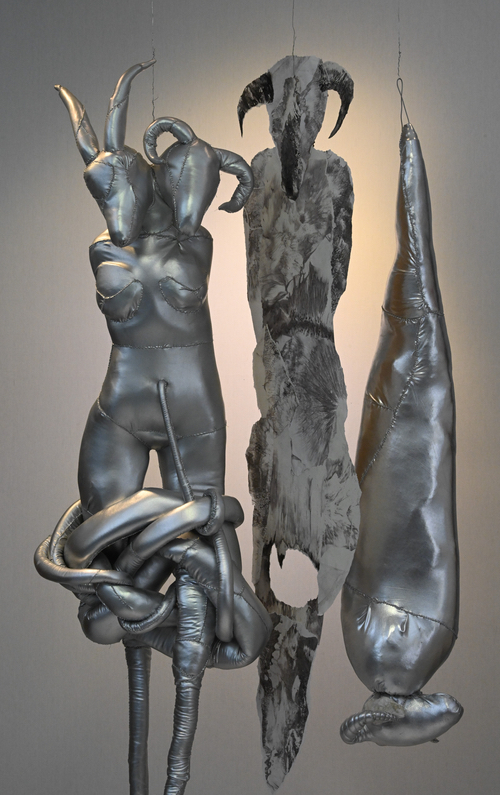
MONGOLIA PAVILION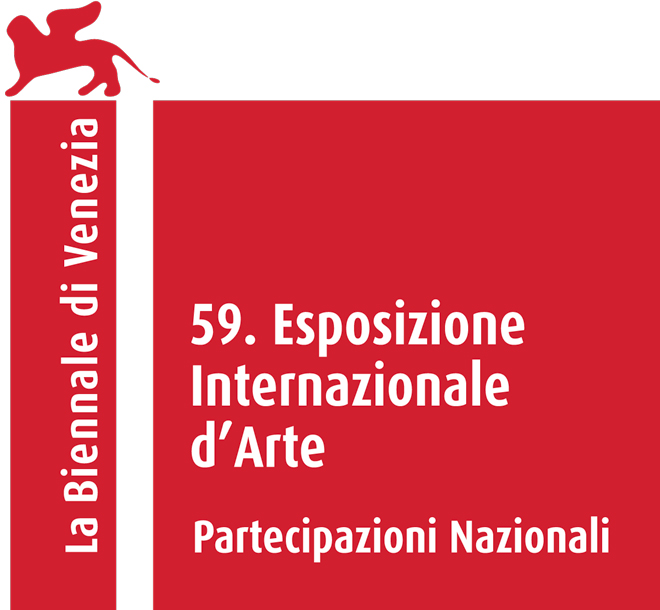
at the 59th International Art Exhibition of La Biennale di Venezia
A Journey Through Vulnerability
The fourth appearance of Mongolia at La Biennale di Venezia features Munkhtsetseg Jalkhaajav (Mugi), one of the foremost figures of contemporary art in Mongolia. During her long-distinguished career, Mugi (b.1967) has significantly contributed to the growth of Mongolian contemporary art and has exhibited locally and internationally in the USA, Germany, Italy, China, Japan, South Korea, Thailand, Taiwan and Hong Kong.
Mugi’s artistic practice incorporates sculptures, paintings, videos and performances, and explores the notion of pain, fear, healing and rebirth. Mainly reflecting her personal experiences, Mugi investigates the complexities of female bodies, minds and souls, and the connection with one-self and nature, capturing the tensions between different realms. Seemingly fictional, yet grounded, her unique works embody invisible forces, such as spirits and myths and tell sensible stories of women, unborn children, and the sorrowful fates of animals.
Inspired by Mongolian traditional healing methods and spiritual therapy, the process of her artistic creation is deeply intuitive and ritual-like. Through embodiments of the subject matter that evoke strong sentiments and juxtapositions of symbolic elements used for healing and protection, she meditatively examines the nature of her own anxiety and the process of its healing. Her ways of tearing, cutting, collating and stitching imply pain, anxiety, fear, hope and patience and creates a specific language that allows Mugi to articulate and manifest her inner feelings and visions. In her works, birds represent the pulse of life, pregnancy, healing and protection, whereas female bodies represent her constant search for inner strength. The concept of reincarnation is the foremost interest of her artistic journey
A Journey Through Vulnerability, presents a series of installations, including soft sculptures, collages and video pieces, created by the artist during the last 15 years. The works are spread across 3 different rooms entitled: “Miscarriage”, “Dream of Gazelle” and “Pulse of Life” and narrate the stories of women and animals, offering the viewer a journey through the intimate, fragile, yet powerful world of Mugi.
The exhibition is curated by Gantuya Badamgarav, art patron and founding director of the Mongolian Contemporary Art Support Association. She initiated and organized Mongolia’s first ever participation at La Biennale di Venezia in 2015 in addition to organizing two subsequent editions and curating the Mongolia Pavilion in 2019. In 2022, Gantuya was invited by the Ministry of Culture of Mongolia to curate again the fourth edition, following a landmark decision made by the Government of Mongolia to henceforth ensure the continued participation of Mongolia at La Biennale di Venezia.
Commissioner: Nomin Chinbat, Minister of Culture of Mongolia Exhibitor: Munkhtsetseg Jalkhaajav
Curator: Gantuya Badamgarav
Organizer: Mongolian Contemporary Art Support Association
Supporters: Ministry of Culture of Mongolia, Ministry of Foreign Affairs of Mongolia, Swiss Agency for International Development and others
Partner in Venice: PDG Arte Communications
Opening hours: Apr 23 to Nov 27, 2022, 10am - 7pm. Closed on Mondays (except Monday 25 April, 30 May, 27 June, 25 July, 15 August, 5 September, 19 September, 31 October, 21 November). Address: Calle S. Biasio, Castello 2131, 30122 Venezia
